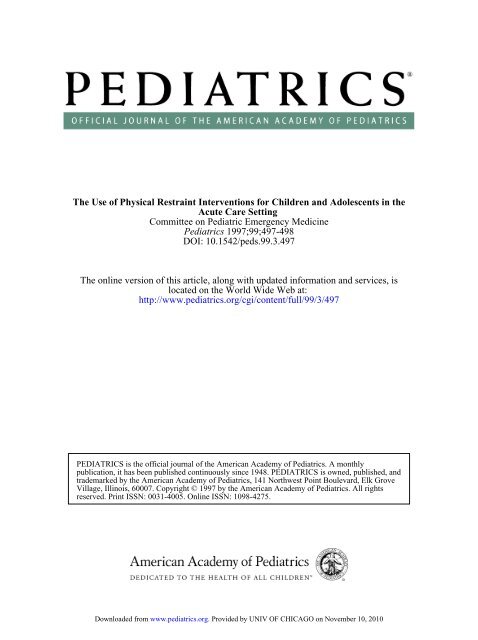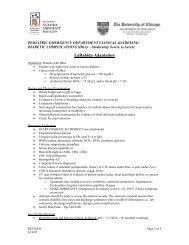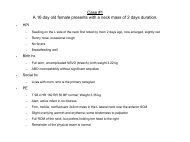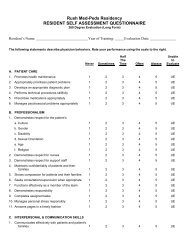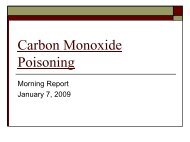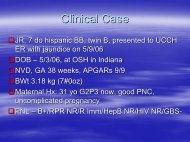The Use of Physical Restraint Interventions for Children
The Use of Physical Restraint Interventions for Children
The Use of Physical Restraint Interventions for Children
You also want an ePaper? Increase the reach of your titles
YUMPU automatically turns print PDFs into web optimized ePapers that Google loves.
<strong>The</strong> <strong>Use</strong> <strong>of</strong> <strong>Physical</strong> <strong>Restraint</strong> <strong>Interventions</strong> <strong>for</strong> <strong>Children</strong> and Adolescents in the<br />
Acute Care Setting<br />
Committee on Pediatric Emergency Medicine<br />
Pediatrics 1997;99;497-498<br />
DOI: 10.1542/peds.99.3.497<br />
<strong>The</strong> online version <strong>of</strong> this article, along with updated in<strong>for</strong>mation and services, is<br />
located on the World Wide Web at:<br />
http://www.pediatrics.org/cgi/content/full/99/3/497<br />
PEDIATRICS is the <strong>of</strong>ficial journal <strong>of</strong> the American Academy <strong>of</strong> Pediatrics. A monthly<br />
publication, it has been published continuously since 1948. PEDIATRICS is owned, published, and<br />
trademarked by the American Academy <strong>of</strong> Pediatrics, 141 Northwest Point Boulevard, Elk Grove<br />
Village, Illinois, 60007. Copyright © 1997 by the American Academy <strong>of</strong> Pediatrics. All rights<br />
reserved. Print ISSN: 0031-4005. Online ISSN: 1098-4275.<br />
Downloaded from<br />
www.pediatrics.org.<br />
Provided by UNIV OF CHICAGO on November 10, 2010
AMERICAN ACADEMY OF PEDIATRICS<br />
Committee on Pediatric Emergency Medicine<br />
<strong>The</strong> <strong>Use</strong> <strong>of</strong> <strong>Physical</strong> <strong>Restraint</strong> <strong>Interventions</strong> <strong>for</strong> <strong>Children</strong> and Adolescents<br />
in the Acute Care Setting<br />
ABSTRACT. This statement defines physical restraint<br />
and provides recommendations <strong>for</strong> its use in children<br />
and adolescents.<br />
<strong>Children</strong> and adolescents may need to be physically<br />
or chemically restrained <strong>for</strong> various procedures,<br />
because <strong>of</strong> disruptive behavior, or to prevent<br />
injury to themselves or others. <strong>The</strong> use <strong>of</strong> restraint<br />
<strong>for</strong> a child or adolescent requires clear indications,<br />
safe application, reassessment guidelines, and use<br />
only after the consideration <strong>of</strong> alternative methods.<br />
Seclusion refers to the involuntary confinement <strong>of</strong> a<br />
patient alone in a room, from which the patient is<br />
physically prevented from leaving, <strong>for</strong> any period <strong>of</strong><br />
time. <strong>The</strong> use <strong>of</strong> seclusion or restraint on children<br />
and adolescents hospitalized <strong>for</strong> psychiatric disorders<br />
has been reviewed by several authors and is<br />
beyond the scope <strong>of</strong> this statement. 1–4<br />
<strong>Restraint</strong>s may be physical or chemical. Chemical<br />
restraint involves the use <strong>of</strong> psychotropic drugs<br />
or sedatives or paralytic agents. <strong>Physical</strong> restraint<br />
involves the use <strong>of</strong> physical or mechanical devices<br />
to restrain movement. <strong>Physical</strong> restraints may be<br />
cloth, leather, metal handcuffs or shackles, car<br />
seats, or seat belts. This statement is limited to the<br />
use <strong>of</strong> physical restraint in children and adolescents<br />
in the acute care or nonpsychiatric inpatient<br />
setting.<br />
In the context <strong>of</strong> this statement, restraint differs<br />
from mechanisms that are usually and customarily<br />
used during transport or during diagnostic or surgical<br />
procedures. Common examples <strong>of</strong> these mechanisms<br />
in emergency department settings are a papoose<br />
board to aid in the control <strong>of</strong> a patient <strong>for</strong> the<br />
repair <strong>of</strong> a laceration or an arm restraint during the<br />
administration <strong>of</strong> intravenous fluids or medications.<br />
Devices used to protect the patient, to support the<br />
patient in a specific position, or to assist in the maintenance<br />
<strong>of</strong> normal body functions are not considered<br />
restraint interventions. Examples <strong>of</strong> these types <strong>of</strong><br />
devices are bed rails, tabletop chairs, and halter-type<br />
or s<strong>of</strong>t-chest restraints. 5<br />
Situations that may require the short-term use <strong>of</strong><br />
restraint in a child or adolescent include extreme,<br />
disruptive, self-injurious, or aggressive behavior as a<br />
result <strong>of</strong> drug intoxication, head injury, cerebrovas-<br />
<strong>The</strong> recommendations in this statement do not indicate an exclusive course<br />
<strong>of</strong> treatment or serve as a standard <strong>of</strong> medical care. Variations, taking into<br />
account individual circumstances, may be appropriate.<br />
PEDIATRICS (ISSN 0031 4005). Copyright © 1997 by the American Academy<br />
<strong>of</strong> Pediatrics.<br />
cular hemorrhage, multiple trauma, or acute psychiatric<br />
disorder. Patients in status epilepticus may<br />
require short-term physical restraint to prevent<br />
injury to self or others until the seizure is controlled<br />
with antiepileptic agents. <strong>The</strong> use <strong>of</strong> the<br />
restraint, however, should not place a child or<br />
adolescent at risk <strong>of</strong> injury or deterioration <strong>of</strong> the<br />
medical condition.<br />
<strong>The</strong> Joint Commission on Accreditation <strong>of</strong> Healthcare<br />
Organizations categorizes the use <strong>of</strong> restraint as<br />
a special treatment procedure requiring special justification<br />
<strong>for</strong> use. A physician’s verbal or written<br />
time-limited order is obtained <strong>for</strong> each use. In addition,<br />
the standards require that hospital policy address<br />
the periodic observation <strong>of</strong> patients <strong>for</strong> whom<br />
restraint or seclusion is used.<br />
Verbal interventions and therapeutic holding<br />
have been used <strong>for</strong> children and adolescents in<br />
psychiatric facilities to avoid the use <strong>of</strong> restraint or<br />
seclusion. 3,4,6 <strong>The</strong>rapeutic holding is the physical restraint<br />
<strong>of</strong> a child by at least two people to assist the<br />
child who has lost control <strong>of</strong> behavior to regain<br />
control <strong>of</strong> strong emotions. <strong>The</strong>se techniques<br />
should also be considered as options <strong>for</strong> use in the<br />
acute care setting.<br />
RECOMMENDATIONS<br />
Policies <strong>for</strong> the use <strong>of</strong> physical restraint <strong>of</strong> children<br />
and adolescents in the acute care or inpatient setting<br />
should include the following:<br />
1. An explanation to children why restraint is necessary,<br />
with the opportunity <strong>for</strong> children to respond<br />
to therapeutic holding when appropriate<br />
and safe.<br />
2. A physician’s written or verbal order specifying<br />
the type <strong>of</strong> restraint to be used and the importance<br />
<strong>of</strong> adequate restraint in relationship to its indication,<br />
with an estimate <strong>of</strong> duration. This order<br />
should be reviewed on an ongoing basis in the<br />
emergency department setting.<br />
3. An immediate documented explanation to parents<br />
or family members as to why restraint is<br />
necessary.<br />
4. An assessment according to hospital guidelines <strong>of</strong><br />
those who have been restrained, assuring that the<br />
restraints are correctly applied, that skin integrity<br />
and neurovascular status remain intact, that restraints<br />
accomplish the purpose <strong>for</strong> which they<br />
were applied, and that the need <strong>for</strong> restraint continues.<br />
PEDIATRICS Vol. 99 No. 3 March 1997 497<br />
Downloaded from<br />
www.pediatrics.org.<br />
Provided by UNIV OF CHICAGO on November 10, 2010
Committee on Pediatric Emergency Medicine,<br />
1995 to 1996<br />
Joseph A. Weinberg, MD, Chairperson<br />
Barbara Barlow, MD<br />
George L. Foltin, MD<br />
Jerome A. Hirschfeld, MD<br />
Dee Hodge III, MD<br />
Jane F. Knapp, MD<br />
William J. Lewander, MD<br />
Karin A. McCloskey, MD<br />
Robert A. Wiebe, MD<br />
Liaison Representatives<br />
Jean Athey, PhD<br />
Maternal and Child Health Bureau<br />
Richard M. Cantor, MD<br />
American College <strong>of</strong> Emergency Physicians<br />
Deborah Mulligan-Smith, MD<br />
National Association <strong>of</strong> EMS Physicians<br />
Max L. Ramen<strong>of</strong>sky, MD<br />
American College <strong>of</strong> Surgeons<br />
James S. Seidel, MD<br />
National EMSC Resource Alliance<br />
AAP Section Liaisons<br />
Patricia J. Davidson, MD<br />
Section on Anesthesiology<br />
Steven E. Krug, MD<br />
Section on Emergency Medicine<br />
David S. Markenson, MD<br />
Section on Residents<br />
Michele Moss, MD<br />
Section on Critical Care<br />
Dennis W. Vane, MD<br />
Section on Surgery<br />
REFERENCES<br />
1. Swett C Jr, Michaels AS, Cole JO. Effects <strong>of</strong> a state law on rates <strong>of</strong><br />
restraint on a child and adolescent unit. Bull Am Acad Psychiatry Law.<br />
1989;17:165–169<br />
2. Crespi TD. <strong>Restraint</strong> and seclusion with institutionalized adolescents.<br />
Adolescence. 1990;25:825–829<br />
3. Kalogjera IJ, Bedi A, Watson WN, Meyer AD. Impact <strong>of</strong> therapeutic<br />
management on use <strong>of</strong> seclusion and restraint with disruptive adolescent<br />
inpatients. Hosp Community Psychiatry. 1989;40:280–285<br />
4. Miller D, Walker MC, Friedman D. <strong>Use</strong> <strong>of</strong> holding technique to control<br />
the violent behavior <strong>of</strong> seriously disturbed adolescents. Hosp Community<br />
Psychiatry. 1989;40:520–524<br />
5. Special treatment procedures. In: Comprehensive Accreditation Manual <strong>for</strong><br />
Hospitals. Oak Brook Terrace, IL: Joint Commission <strong>of</strong> the Accreditation<br />
<strong>of</strong> Healthcare Organizations; 1996:189–191<br />
6. Barlow DJ. <strong>The</strong>rapeutic holding. Effective intervention with the aggressive<br />
child. J Psychosoc Nurs Ment Health Serv. 1989;27:10–14<br />
498 USE OF PHYSICAL RESTRAINT INTERVENTIONS<br />
Downloaded from<br />
www.pediatrics.org.<br />
Provided by UNIV OF CHICAGO on November 10, 2010
<strong>The</strong> <strong>Use</strong> <strong>of</strong> <strong>Physical</strong> <strong>Restraint</strong> <strong>Interventions</strong> <strong>for</strong> <strong>Children</strong> and Adolescents in the<br />
Acute Care Setting<br />
Committee on Pediatric Emergency Medicine<br />
Pediatrics 1997;99;497-498<br />
DOI: 10.1542/peds.99.3.497<br />
Updated In<strong>for</strong>mation<br />
& Services<br />
References<br />
Citations<br />
Subspecialty Collections<br />
Permissions & Licensing<br />
Reprints<br />
including high-resolution figures, can be found at:<br />
http://www.pediatrics.org/cgi/content/full/99/3/497<br />
This article cites 5 articles, 2 <strong>of</strong> which you can access <strong>for</strong> free at:<br />
http://www.pediatrics.org/cgi/content/full/99/3/497#BIBL<br />
This article has been cited by 1 HighWire-hosted articles:<br />
http://www.pediatrics.org/cgi/content/full/99/3/497#otherarticles<br />
This article, along with others on similar topics, appears in the<br />
following collection(s):<br />
Emergency Medicine<br />
http://www.pediatrics.org/cgi/collection/emergency_medicine<br />
In<strong>for</strong>mation about reproducing this article in parts (figures,<br />
tables) or in its entirety can be found online at:<br />
http://www.pediatrics.org/misc/Permissions.shtml<br />
In<strong>for</strong>mation about ordering reprints can be found online:<br />
http://www.pediatrics.org/misc/reprints.shtml<br />
Downloaded from<br />
www.pediatrics.org.<br />
Provided by UNIV OF CHICAGO on November 10, 2010


